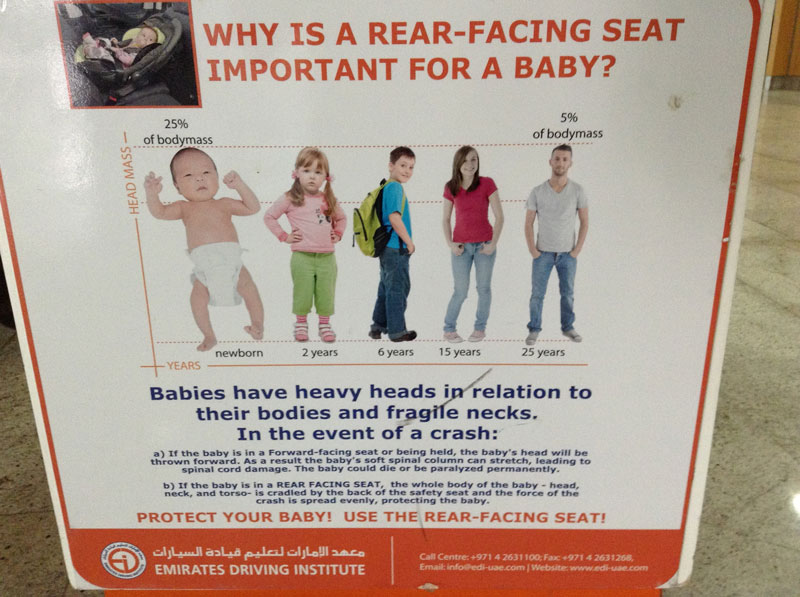- City Fajr Shuruq Duhr Asr Magrib Isha
- Dubai 04:32 05:49 12:21 15:48 18:47 20:04
Although child seats in cars are not mandatory, they are needed, say experts on child safety in traffic on the sidelines of the Gulf Traffic Week organised by the Road and Transport Authority (RTA).
Child seats being the topic of discussion during last year’s Gulf Traffic Week, too, the anticipation was born of a law-in-the-making, stipulating that child seats are mandatory for certain age groups.
This is unlikely in 2014, according to Major General Mohammed Saif Al Zafeen, Head of the Federal Traffic Council, who says: “Until now seat belts in the back seat are not mandatory. When discussing child seats in the car, seat belts form an important aspect, so this must be addressed first. This has been a topic of discussion in the Traffic Council,” he acknowledged.
This week a child seat will be given away in a daily draw held in Dubai Hospital and Latifa Hospital by the RTA in cooperation with the Health Department.
The educational training at JSS was organised by the RTA in cooperation with Emirates Driving Institute, Civil Defense, Dubai Taxi Corporation, the Saudi German Hospital, Al Marai and the Green Bus.
Pupils were instructed how to carry each other out when one of them would have sustained an injury, and how to extinguish a fire in a lecture from the Civil Defence. Educational material was handed regarding traffic safety, vehicle maintenance and other safety-related subjects.
Four different seats or cushions were presented by the Emirates Driving Institute at the JSS International School in Al Barsha on Monday, where children of seven schools came together to learn more about safety related issues. The seats may have made little appeal to pupils, but the message to parents was apparent: these seats are a must for children under the age of 14.
According to Mohammad Intiaz, driving instructor who was at the location to explain the necessity, there are four categories corresponding to the age and height categories of children. As a start, every infant below the age of 1 must be seated in an infant seat; a carriage-shaped seat that allows the infant to lie down while being in the car.

“The neck is the most fragile part of a newborn’s body and it comprises 25 per cent of the total body weight. It must be supported at all times. This seat does that,” clarifies Mohammad. Furthermore, the infant seat must be placed on the back seat facing the rear of the vehicle, so that when the driver suddenly pushes the break, the neck does not get pressured.
When the child is older, it is safe for the child to face the front of the vehicle, and ideally this should be from what the school refers to as the child seat.
"The seat, suitable for children between 1 and 4 or of the height between 65cm and 95 cm, allows the child to sit up straight albeit supported by the full structure of the seat and the built-in buckle. “It is best when this child seat is placed in the middle of the back seat, so the parent can easily check on the wellbeing of the child through the rear mirror,” explained Mohammad.
However, in both the infant seat and child seat it is very important that not only is the child strapped within the seat, but also the seat is buckled up by seat belt at the back of the car, he emphasised.
When the child is older than four years old and taller than 95 cm, the seat straps are no longer required and the main safety guarantee is the car seat belt. However, the height of the child may not be enough for the seat belt to be fully functional. “When this is the case, the seat belt will strap the neck of the child and, therefore, not provide the full safety it is supposed to. A booster seat is required to lift up the child.
The booster seat is a heightened cushion with back support, but without straps. A similar structure without back support is the booster cushion, which is required for children taller than 1.25 cm.

Above the age of 13 and the height of 1.45 cm, the child can safely sit in the back or even the front of the car provided that (s)he is buckled up, adds Mohammad.
Below the age of 13 the child should never sit in the front. “If an airbag would be released this would possibly harm the ribs of the child, as it is released with a speed of 500kmph. Keeping a child under the same seat belt does not guarantee safety, as the seat belt is made to protect one person.”
The elaborate explanations of the driving instructors are merely guidelines, but form the basics to which many experts have agreed over the years. Accordingly 65 per cent of traffic accidents injuring children are due to the fact that the child did not enjoy the full safety support it could have had.
[Homepage Image Courtesy: Shutterstock]
![]() Follow Emirates 24|7 on Google News.
Follow Emirates 24|7 on Google News.